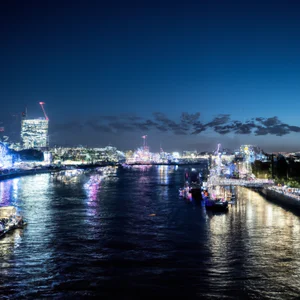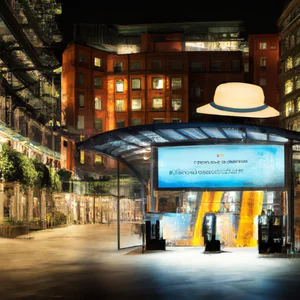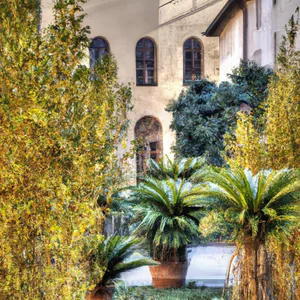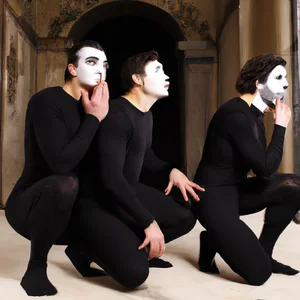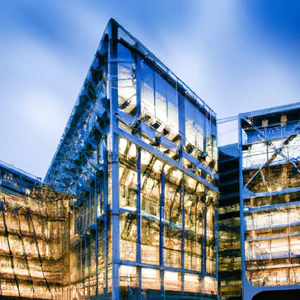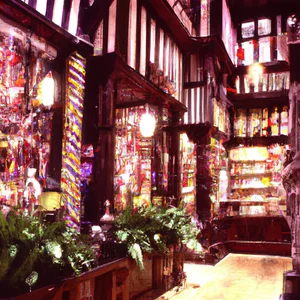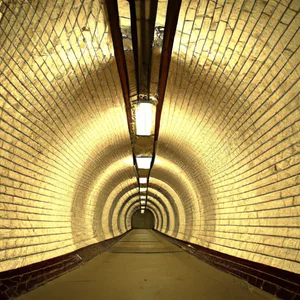Book your experience
Millennium Bridge: The pedestrian bridge that connects St Paul's to the Tate Modern
The Millennium Bridge, everyone knows, is that pedestrian bridge that connects St Paul’s to the Tate Modern. It’s a kind of catwalk that makes you feel a bit like you’re walking on a work of art, huh? When you walk through it, you have this spectacular view of St Paul’s Cathedral on one side and the modern Tate on the other. It’s like a contrast between past and present, a sort of meeting between two worlds, and I have to say it’s really fascinating.
I’ll tell you, the last time I was there, it was a beautiful sunny day and people were everywhere. There were those who took selfies, those who simply enjoyed the view. And I, between chats with a friend, realized how strange this place is. I don’t know, maybe it’s the way the bridge moves slightly when you walk on it, which gives you that feeling of being in unstable balance, like you’re dancing on a tightrope.
Well, I have to say that while I was walking, I don’t know, I felt a bit part of history, but also a bit like a tourist, in short, a curious mix. It may seem banal, but it’s as if every step tells a story, and I’m not just talking about mine. It’s a place where different types of people intersect and, well, everyone has their own journey to tell.
I don’t know, but I think that this bridge, with its innovative design, is truly a symbol of London, and I’m not just saying that. It’s as if, in a certain sense, it has a soul of its own. Of course, there are always a few tourists who slow you down, and sometimes I wonder if there will ever be a time when there will be fewer people, but oh well, it’s part of the game.
In short, if you happen to pass by there, I recommend you stop by. You won’t be disappointed, and who knows, maybe you’ll feel like you’re traveling through time too!
Millennium Bridge: An icon of modern architecture
A close encounter with design
I remember the first moment I set foot on the Millennium Bridge: the crisp London air, the River Thames sparkling in the sun’s rays and, above all, the stunning architecture of the bridge rising gracefully. This pedestrian bridge, opened in 2000, is a sublime example of modern architecture, designed by Sir Norman Foster and Sir Anthony Caro. Its elegant shape, with clean lines and minimalist design, makes it a symbol of innovation and modernity that attracts visitors from all over the world.
Practical information
The Millennium Bridge spans 325 metres, connecting St Paul’s Cathedral and the Tate Modern. Despite its beauty, it is important to note that the bridge was designed to withstand a large influx of pedestrians. According to a report by Transport for London, the bridge can support up to 2000 people at a time. Be sure to visit during peak hours to soak up the lively atmosphere of this public space.
An insider tip
If you want a unique experience, try to cross the bridge during the week, preferably early in the morning. This way, you can enjoy the tranquility of the place before the crowds start to gather. Also, don’t forget to bring a camera with you: the morning light creates plays of shadows and reflections on the bridge that are simply breathtaking.
Cultural and historical impact
The Millennium Bridge is not just a walkway; represents an important urban intervention that has transformed the surrounding area. It has helped to unite communities and promote greater accessibility between central London and the south of the Thames. Its construction paved the way for a series of cultural and artistic developments, making the area a hub for events and activities.
Sustainability and responsibility
From a sustainability perspective, the Millennium Bridge is an example of how modern architecture can integrate harmoniously into the urban landscape. Its design took into account the environmental impact, promoting ecological modes of transport and encouraging responsible tourism. Walking instead of using polluting transportation is a great way to explore the city.
A vibrant atmosphere
Walking across the Millennium Bridge, you will feel like you are part of a living work of art. Street artists performing, families strolling and tourists taking photos create a vibrant and dynamic atmosphere. It’s a place where London’s past and future meet, and where every step tells a story.
Activities to try
To make your visit even more memorable, I recommend stopping by the Tate Modern after crossing the bridge. Not only will you be able to admire world-famous contemporary art, but you will also be able to enjoy coffee in their atmospheric restaurant, overlooking the River Thames.
Myths and misconceptions
A common misconception is that the Millennium Bridge is just a simple link between two tourist attractions. In fact, it is an experience in itself: a work of art that invites us to reflect on the relationship between architecture, art and community.
A final reflection
As you walk along the Millennium Bridge, ask yourself: How do the places we pass through shape our understanding of the city and its stories? Each step on this bridge is not just a physical movement, but a journey through time and space, an invitation to discover London in a new light.
Fascinating story: From planning to construction
I still remember the first time I was enchanted by the Millennium Bridge. Walking along the Thames, the structure seemed to dance on the river, a perfect marriage of art and engineering. Its history, however, is just as fascinating as the modern appearance it presents today.
A journey through time
Designed by architect Sir Norman Foster and engineer Arup, the Millennium Bridge opened in 2000 to celebrate the new millennium. Its creation was a bold response to the growing need to connect the two banks of the river, uniting central London with the Tate Modern and the Globe Theatre. However, it has not been an obstacle-free journey. During its opening, the bridge exhibited a striking “wobble effect” which forced authorities to temporarily close it. This event led to an engineering overhaul that consolidated the structure, transforming it into the icon we know today.
Unconventional advice
If you want to discover a little-known detail, take note: the Millennium Bridge is designed to “dance” with its visitors. Unlike many bridges, which are static, this bridge offers an interactive experience. The movement of the bridge is intended to absorb the vibrations caused by pedestrians’ steps, making each crossing a lively and dynamic experience. Try to walk in sync with other visitors; the sensation of “dance” that results is truly unique.
Cultural impact and sustainability
Culturally, the Millennium Bridge has become a symbol of contemporary London. It is not only a physical connection, but also a bridge between the past and the future, between tradition and innovation. Furthermore, it represents an example of sustainable tourism: its design and use of ecological materials reflect the city’s commitment to a greener future.
An experience not to be missed
As you stroll across the bridge, take a moment to observe the street artists who often perform. Their music and performances add a vibrant atmosphere to the experience, making each visit an opportunity to immerse yourself in the local culture.
Final reflection
Walking over the Millennium Bridge is not just a way to cross the Thames; is a journey through London’s recent history. Have you ever wondered how a simple bridge can contain so many stories and meanings? Next time you will visit London, stop to reflect on the impact this extraordinary example of architecture has had on the city and on you.
Crossing the bridge: A unique pedestrian experience
I remember the thrill I felt the first time I crossed the Millennium Bridge. It was a spring morning, and the sun reflected on the water of the Thames, creating a magical play of light. Every step on the bridge, with the wind caressing your face and the sound of your footsteps mixing with the rustling of the waves below, seemed like an invitation to discover something unique. The Millennium Bridge is not just a means of crossing the river; it is an experience that involves all the senses.
A pedestrian attraction between history and modernity
The Millennium Bridge is designed for pedestrians and cyclists, meaning that as you cross it, you have the opportunity to appreciate the view of the Thames from a completely new perspective. On one side, you can admire the majestic St. Paul’s Cathedral, and on the other, the dynamic London skyline, which tells the story of an ever-changing city. Walking along this bridge is like walking through a work of art, where every step is accompanied by history that unfolds at your feet.
A little-known tip
A secret that few know is that, if you stop halfway across the bridge and listen carefully, you might hear the sound of the water flowing beneath you, mixed with the buzz of the city. It’s a moment of tranquility in an otherwise crowded place, perfect for reflecting and savoring the beauty that surrounds you. Furthermore, if you are a photography enthusiast, I recommend visiting the bridge in the early hours of the morning, when the light is soft and tourists are still few; You will thus have the opportunity to capture breathtaking images without distractions.
Cultural impact and hidden stories
The Millennium Bridge has had a significant impact on London culture, becoming a symbol of modernity and innovation. Opened in 2000, it linked two major cultural institutions: the Tate Modern and Shakespeare’s Globe Theatre. Crossing the bridge is, therefore, also a journey between art and history. It is not uncommon to come across street artists performing along the route, making your walk even more lively and engaging.
Responsible tourism practices
If you are thinking of visiting the Millennium Bridge, remember to respect the environment. The surrounding area is designed to be pedestrian-friendly, promoting sustainable tourism. Avoid using motorized vehicles nearby and consider going for a walk, perhaps combining your visit with a walk in the surrounding parks, such as Bankside Garden.
An experience not to be missed
When you cross the Millennium Bridge, take a moment to stop and take in the view. Consider visiting the Tate Modern, where you can admire contemporary works of art that stimulate thought and inspiration. Don’t forget to try a coffee at one of the small kiosks nearby, where you can enjoy a hot drink while watching the world go by.
Final reflections
The Millennium Bridge is not just a bridge; it is a symbol of connection and innovation, a place where past and future meet. Have you already had the opportunity to go through it? What was your experience? We invite you to consider this place not just as a transit point, but as an opportunity to discover London in a completely new way.
Panoramic view: Discover London from above
When I stepped onto the Millennium Bridge for the first time, a thrill of excitement ran through me. Walking along this extraordinary structure, I looked up and was enchanted by the view that opened up before me. On one side, the majestic profile of St. Paul’s Cathedral stood out against the sky, while on the other, the River Thames sparkled in the sun’s rays, reflecting the vibrant colors of the surrounding buildings. Every step on the bridge seemed to tell a story, and every view was a work of art.
A unique observation experience
The Millennium Bridge, opened in 2000, is much more than just a pedestrian link between the Tate Modern and St. Paul’s Cathedral; it is a privileged observation point to admire London from above. The 325 meter long pedestrian walkway offers an unparalleled perspective on the city, with landscapes ranging from historic monuments to modern skyscrapers. According to VisitLondon.com, the bridge was designed to be a fusion of functionality and beauty, and visitors can easily spend hours just walking around and enjoying the view.
An insider tip
If you want to have a truly unforgettable experience, I recommend visiting the Millennium Bridge at sunrise. As the city begins to wake up and the soft morning light reflects on the water of the Thames, the bridge becomes a place of peace and serenity. Not only will you have the chance to take photographs without the crowds, but you will also have the opportunity to see London in a whole new light.
Cultural and historical impact
The Millennium Bridge has had a significant impact on London culture. Not only has it transformed the way pedestrians cross the Thames, it has also inspired artists and photographers, becoming an iconic subject for artwork and photography. Furthermore, its construction represented a symbol of innovation and modernity in a city rich in thousand-year history.
Sustainability and responsible tourism
Walking on the Millennium Bridge is also a step towards sustainable tourism practices. Discovering the city on foot reduces environmental impact and promotes a healthier lifestyle. Additionally, the bridge was designed to withstand extreme weather conditions, which demonstrates a commitment to long-term sustainability.
An invitation to discover
If you want an experience that combines beauty and history, don’t miss the opportunity to cross the Millennium Bridge. Bring a camera with you and take the time to observe every detail around you. And if you fancy a tip, try exploring the nearby Borough Markets after your walk; it’s a fantastic way to immerse yourself in the local culture and taste delicious traditional dishes.
Final reflection
The Millennium Bridge is not just a bridge; it is a gateway to a new perspective on London. What is your favorite view of the city? Have you ever thought about how a simple crossing can turn into a memorable experience? Let yourself be carried away by the beauty of this place and discover how amazing it can be to see the world from another angle.
Art and Culture: The Works of the Tate Modern
A personal experience
I still remember the first time I visited the Millennium Bridge. As I crossed the bridge, with the Thames sparkling in the midday sun, my eye was drawn to the majestic Tate Modern, a former power station transformed into one of the world’s most important contemporary art museums. Its gray and austere facade contrasted with the liveliness of the works displayed inside, and I felt like an explorer in unknown territory, ready to discover the extraordinary things modern art had to offer.
Practical information
Tate Modern is not just a museum; it is a real cultural center that hosts works by artists of the caliber of Picasso, Warhol and Hockney. Located a short walk from the Millennium Bridge, entry is free to the permanent collections, making it accessible to all. For those who wish to delve deeper, guided tours and temporary exhibitions are available and require a ticket. I recommend you check the official Tate Modern website for updates on current events and exhibitions.
A unconventional advice
If you want an experience that few tourists know about, try visiting the Tate Modern on a Friday evening when the museum is open until 10pm. Not only will you have the opportunity to explore the exhibitions without the crowds, but you can also attend events special events such as concerts or artistic performances that take place sporadically. This is a unique way to immerse yourself in local art and culture.
Cultural and historical impact
Tate Modern has revolutionized the way we perceive contemporary art, attracting visitors from all over the world and helping to make London a cultural epicentre. The museum represents an ongoing dialogue between the past and the present, offering a space where ideas can be explored and contested. Its presence next to the Millennium Bridge is not just symbolic; represents a bridge between art and everyday life, inviting everyone to reflect on what it means to be human in an ever-changing world.
Sustainable tourism
Tate Modern promotes sustainable practices, from the use of renewable energy to reducing waste. By participating in education programs and community initiatives, visitors can contribute to a culture of ecological responsibility. It is a great example of how art can be a vehicle for social and environmental change.
Immersion in the atmosphere
Imagine walking along the river, with the sound of gently flowing water and the fresh London air enveloping you. Every step on the Millennium Bridge brings you closer not only to one of the city’s most iconic architectural works, but also to a treasure trove of creativity and innovation. The atmosphere is tangible; art becomes part of your experience, and every corner of Tate Modern tells a story worth hearing.
Recommended activity
If you have time, don’t miss the opportunity to go up to the museum’s restaurant, the Tate Modern Café, located on the sixth floor. Here you can enjoy a coffee while admiring spectacular views of the city. This is the perfect way to end your visit, reflecting on the works of art you’ve just seen.
Myths and misconceptions
A common misconception is that Tate Modern is only for art experts. In fact, the museum is designed for everyone, from novices to enthusiasts. The works are presented in an accessible way, and there are many resources to help visitors understand and appreciate contemporary art.
Final reflection
After visiting the Tate Modern, you will find yourself looking at the world with different eyes. The works you have seen will invite you to consider new perspectives on life and society. Which work struck you the most? And how might art influence your view of the world?
A unique tip: Visit at sunset for the magic
Imagine standing at the Millennium Bridge as the sun begins to set, painting the sky in shades of orange and pink. The first time I crossed the bridge at sunset, I was enchanted by the transformation taking place around me. The waters of the Thames reflected the colors of the sky, while the silhouettes of London’s monuments stood out against the horizon. It’s a moment that makes you feel part of the city, an instant of pure beauty that captures your heart.
Practical information
To live this magical experience, I recommend arriving at the Millennium Bridge at least an hour before sunset. You can check the sun times via local apps like Time and Date or Weather.com, so you don’t miss a moment of this show. Access to the bridge is free, and although it can be crowded with tourists, the sunset offers a unique atmosphere worth sharing.
An insider tip
If you want an even more atmospheric experience, bring along a blanket and a thermos of hot tea. Find a quiet spot on the deck or near the Tate Modern, where you can enjoy your tea while observing the world around you. It’s a simple but effective way to fully immerse yourself in the atmosphere of London as night falls.
Cultural impact
The Millennium Bridge, designed by architect Sir Norman Foster, is not only a work of architectural art; it is also a symbol of connection between the different souls of London. Crossing it at sunset makes you appreciate not only the beauty of the city, but also its cultural dynamism, combining art, history and modernity in a single sensorial experience.
Sustainability and responsible tourism
In an age where sustainability is key, visiting the Millennium Bridge at sunset is an eco-friendly option: you can easily get there on foot or by bike, avoiding traffic and helping to reduce pollution. Plus, many of the cafes and restaurants along the route are committed to using local ingredients and sustainable practices, making your experience even more responsible.
Soak up the atmosphere
As you walk across the bridge, let the sounds of the city envelop you: the murmur of people, the sound of crashing waves and the distant echo of street musicians. Every step is an invitation to discover hidden stories and connect with the vibrant essence of London.
Suggested activity
After crossing the bridge, I recommend taking a stroll through the nearby Borough Market, where you can enjoy delicious local and international dishes. It’s the perfect culmination of a magical evening, enjoying the flavors of the capital as day turns into night.
Myths and misconceptions
A common misconception is that the Millennium Bridge is just a passageway for tourists. In fact, it is a meeting place for Londoners and often hosts events and artistic performances, making it a vital hub of the community. Don’t let its fame fool you: this bridge is much more than just a tourist attraction.
Final reflection
Now that you have discovered the magic of visiting the Millennium Bridge at sunset, I invite you to reflect: what other unique experiences could you discover in your city, simply by observing the world around you? Beauty is often found in the details, you just need to know how to look for it.
Sustainability in action: The bridge and responsible tourism
Sipping an organic coffee in one of the many cafes along the River Thames, I found myself gazing at the Millennium Bridge as pedestrians moved in a fluid ballet of urban life. This bridge, a masterpiece of modern architecture, is not only a symbol of connection between the past and the present, but is also a striking example of how tourism can be sustainable and responsible.
A bridge to the future
Built in 2000, the Millennium Bridge is not just a pedestrian route but an emblematic example of eco-sustainable design. Its steel structure and minimalist design not only catch the eye, but also reduce environmental impact. According to the Greater London Authority, the bridge was designed to optimize natural light and minimize energy use, making it a model of efficiency.
An insider tip
If you want to discover the sustainable side of the Millennium Bridge, I recommend you join one of the guided tours organized by Green London Tours. These experiences will not only take you to explore the bridge, but will also give you great insight into the responsible tourism practices that London is adopting. You’ll discover how local initiatives are working to protect the environment and support communities.
A lasting cultural impact
The Millennium Bridge has changed the way Londoners and tourists interact with the city. Its opening has spurred an increase in responsible tourism, encouraging people to walk and use public transport. This choice not only reduces pollution, but it also promotes greater awareness of the importance of sustainability.
Responsible tourism practices
Many visitors are unaware that the bridge is part of a wider route of eco-sustainable initiatives along the Thames. The surrounding areas have been redeveloped to include green spaces and pedestrian paths, encouraging more sustainable mobility. Furthermore, the Tate Modern, a short walk from the bridge, is actively involved in public art projects that raise visitors’ awareness of the importance of sustainability.
An experience that makes the difference
As you cross the Millennium Bridge, take a moment to reflect on how your tourism choices can contribute to a more sustainable future. For a unique experience, consider attending a River Thames clean-up event, often organized by local associations. Not only will you help keep the city clean, but you will also have the opportunity to meet other people who are passionate about responsible tourism.
Myths to dispel
It is often believed that sustainable tourism is expensive and complicated. In fact, small changes, like choosing to walk or use public transportation, can have a big impact. The Millennium Bridge is the ideal place to start this journey towards a more conscious and respectful form of tourism.
A final reflection
As you walk away from the bridge, ask yourself: How can I contribute to more sustainable tourism on my next adventure? Every step we take can be a choice towards a better future, and the Millennium Bridge is a perfect reminder of how much we can accomplish together.
Historical curiosities: Legends of the Millennium Bridge
Imagine yourself standing on the Millennium Bridge, surrounded by morning fog, as the first rays of sunlight reflect on the waters of the Thames. Every step you take on this bridge is not just a moment of transit, but a connection with stories and legends that have marked its existence. I remember my first encounter with this iconic place; while I was crossing the bridge, an elderly gentleman approached me and, with a mischievous smile, began to tell about the rumors circulating regarding mysterious phenomena related to the bridge.
Legends and mysteries
The Millennium Bridge, with its cutting-edge design, is often shrouded in an aura of mystery and historical curiosity. One of the most fascinating legends is the one linked to its inauguration, when, during the first day of opening, the bridge began to sway in a disturbing way under the weight of pedestrians. This phenomenon has led to rumors of “restless spirits” from the waters of the Thames, who wanted to hinder the passage of visitors. Although this is a fanciful explanation, the bridge actually underwent stabilization work, which resolved movement problems and strengthened its structure.
Local advice and practices
One of the lesser known tips is how Londoners often use the Millennium Bridge as a meeting point. Many residents meet in the surrounding cafes and markets, creating a lively community that gathers to discuss and share stories. If you want to immerse yourself in the local culture, take time to explore the surrounding area, discovering small cafés offering artisanal delicacies. A great choice is the “Tate Modern Café”, which offers spectacular views of the bridge itself.
The cultural impact
The Millennium Bridge is not just an architectural structure; it has become a symbol of modern London, representing the connection between the past and the future. Its history, from initial criticism to its repairs, reflects the resilience and innovation of London culture. Walking on this bridge, you can almost feel the heartbeat of the city evolving, uniting different generations and cultures.
Sustainability and responsible tourism
In the context of sustainable tourism, the Millennium Bridge represents an example of how modern architecture can integrate into the urban fabric without compromising the environment. Its design took into account the ecological impact, promoting pedestrian access that encourages visitors to explore London on foot, thus reducing the use of polluting means of transport.
An activity worth trying
For a truly unique experience, try taking part in one of the historic walks organized along the bridge. These guided tours will not only take you to explore the Millennium Bridge, but will also show you the hidden stories and legends surrounding the area. A perfect way to discover London through the eyes of those who live there every day.
Final reflection
As you cross the Millennium Bridge, I invite you to reflect: what stories and legends will this bridge have to tell future visitors? Every walk on this elegant steel ribbon is a journey through time, an opportunity to connect with the history of London and its countless narratives. Don’t forget to listen to the voices of the past as you venture into the present.
Local Encounters: Cafes and markets along the way
When I visited the Millennium Bridge for the first time, I couldn’t help but notice the vibrant energy in the air. As I walked across the bridge, the view of the Thames unfolding beneath me was extraordinary, but what made the experience truly memorable was what lay immediately beyond its ends. Once off the bridge, I found myself immersed in the pulse of London life, surrounded by welcoming cafes and bustling markets.
Coffee to discover
At the exit of the Millennium Bridge, towards the Tate Modern side, I found a small cafe called Coffee & Chocolate. Here, the scent of freshly ground coffee mixes with the enveloping aroma of artisanal chocolate. It’s the perfect place for a refreshing break after crossing the bridge. Don’t miss their dark chocolate cake, which is a real indulgence!
Markets and liveliness
Continuing towards Borough Market, a London culinary icon, you will discover a world of color and flavour. This market, just a few steps from the bridge, is a food lover’s paradise. Here you can savor everything from local cheeses to international delicacies, while vendors share fascinating stories about their products. It is an experience that goes beyond simple shopping: it is an encounter with the gastronomic culture of the city.
An insider tip
If you want an even more authentic experience, I recommend visiting the markets during the week, when the flow of tourists is smaller. You’ll be able to chat with the sellers and maybe discover an exclusive product that you wouldn’t find on crowded weekends. Plus, many of them are passionate about sustainability and responsible tourism practices, so don’t hesitate to ask about their production methods!
Cultural impact
The Millennium Bridge is not just a pedestrian crossing; it is a crossroads of cultures and histories. Its proximity to art spaces such as the Tate Modern and vibrant local markets has helped create a cultural ecosystem where art and food intertwine, making London one of the most dynamic cities in the world.
Final reflections
In a fast-paced world, crossing the Millennium Bridge and then stopping in a café or market is an invitation to slow down and savor life. Next time you find yourself in London, I invite you to pause and consider: what is the story each café and market has to tell you? Isn’t this the true heart of the city?
Special Events: Discover activities and festivals on the bridge
An experience I will never forget
I still remember my first visit to Millennium Bridge during one of London’s summer festivals. The sun slowly sank below the horizon, painting the sky in shades of gold and pink, while a group of street performers performed an engaging dance. The atmosphere was electric, and the bridge, with its unique architecture, seemed to pulsate with life and creativity. This place, a symbol of innovation, becomes a vibrant stage for events that unite people from all over the world.
Practical information about festivals
The Millennium Bridge is often the focus of special events, such as the Thames Festival and the London Bridge City Summer Festival, which offer a variety of activities from concerts to art installations. To keep up to date with ongoing events, I recommend you visit the Visit London official website or the Southbank Centre events page. These events are not only an opportunity to have fun, but also to immerse yourself in London culture.
An insider tip
If you want a truly unique experience, try to attend one of the silent discos organized on the deck, where participants dance wearing wireless headphones. It’s a fascinating way to enjoy music in the historic atmosphere of London, without disturbing the rest of the world.
The cultural impact of the Millennium Bridge
The Millennium Bridge is not only an artery connecting two banks of the Thames, but has become a symbol of London’s modernity and cultural rebirth. Hosting events and festivals on the bridge helps create a sense of community and strengthen the city’s cultural identity. Its opening marked a change in the way Londoners and tourists interact with the river and public spaces.
Sustainability and responsibility
In an age where responsible tourism is more important than ever, many events on the Millennium Bridge place a strong emphasis on sustainability. For example, many events promote the use of recycled materials and environmentally friendly practices. Participating in these events means not only having fun, but also supporting more responsible tourism.
Soak up the atmosphere
Imagine walking along the bridge, surrounded by artists, musicians and enthusiastic spectators as the River Thames sparkles in the setting sun. Laughter and music create a festive atmosphere that is difficult to describe in words, an experience that touches the heart and stimulates the soul.
Activities to try
If you’re in London during a special event, don’t miss the chance to take part in one of the many interactive activities taking place on the bridge. From dance to street theatre, each event offers something unique. I advise you to bring a camera, as you will have the opportunity to capture unforgettable moments.
Myths and misconceptions
A common misconception is that the Millennium Bridge is always crowded and difficult to enjoy. In reality, during events, the crowds disperse and, with a little patience, you can find quiet corners to fully appreciate the beauty of the bridge and the surrounding atmosphere.
Final reflection
Next time you’re in London, consider planning your visit to coincide with one of the events on the Millennium Bridge. We invite you to reflect on how a simple walk can transform into an unforgettable experience. What event are you most curious about?

 Architecture and Design
Architecture and Design Cities and Regions
Cities and Regions Culture and History
Culture and History Events and Festivals
Events and Festivals Fashion and Shopping
Fashion and Shopping Food and Wine
Food and Wine Nature and Adventure
Nature and Adventure Unique Experiences
Unique Experiences



















